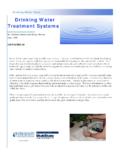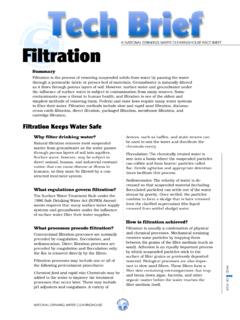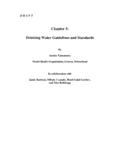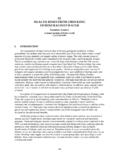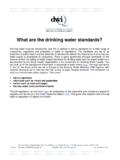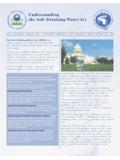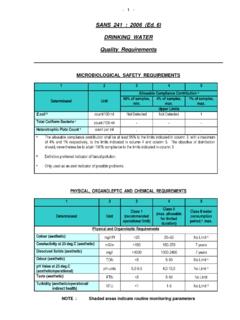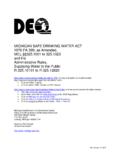Transcription of Point-of-Use or Point-of-Entry Treatment Options …
1 United States Environmental Protection Agency Office of water 4607 EPA 815-R-06-010 April 2006 Point-of-Use or Point-of-Entry Treatment Options for small drinking water Systems Prepared For: Environmental Protection Agency Office of Ground water and drinking water Standards and Risk Management Division Prepared By: The Cadmus Group, Inc. Arlington, VA Printed on Recycled Paper i This document provides public water systems and States with the Environmental Protection Agency s (EPA s) current policy on Point-of-Use and Point-of-Entry devices used for compliance. The statutory provisions and EPA regulations presented in this document contain legally binding requirements. This document is not a regulation itself, nor does it change or substitute for those provisions and regulations.
2 Thus, it does not impose legally binding requirements on EPA, States, or public water systems. This guidance does not confer legal rights or impose legal obligations upon any member of the public. While EPA has made every effort to ensure the accuracy of the discussion in this guidance, the obligations of the regulated community are determined by statutes, regulations, or other legally binding requirements. In the event of a conflict between the discussion in this document and any statute or regulation, this document would not be controlling. The general descriptions provided here may not apply to a particular situation based upon the circumstances. Interested parties are free to raise questions and objections about the substance of this guidance and the appropriateness of the application of this guidance to a particular situation.
3 EPA and other decision-makers retain the discretion to adopt approaches on a case-by-case basis that differ from those described in this guidance where appropriate. POU can refer to several different types of units: plumbed-in units; plumbed-in units with separate faucets for the POU device; faucet-attached units; and faucet-connected counter top units. This document focuses on plumbed-in units with separate faucets for the POU device. Such units are typically installed under the kitchen sink so as to provide convenient use for drinking and cooking water . Separate faucets allow for the use of untreated water for washing and cleaning, thus helping to reduce operating costs of the Treatment device. Mention of trade names or commercial products does not constitute endorsement or recommendation for their use.
4 This is a living document and may be revised periodically without public notice. EPA welcomes public input on this document at any time. This document reflects the comments received from stakeholders on the March 2002 draft and has undergone peer review by experts in the field of POU and POE devices. The term State as used in this document means both State and Primacy Agency. iiiPoint-of-Use or Point-of-Entry Treatment Options for small drinking water Systems Contents 1. Introduction 1-1 2. Federal Requirements for POU/POE 2-1 Safe drinking water Act 2-1 Federal Regulations 2-1 40 CFR Section - Criteria and Procedures for PWSs Using POE Devices 2-2 40 CFR Section - Variances and Exemptions from the MCLs for Organic Chemicals and IOCs 2-3 40 CFR Section (f) 2-3 40 CFR Section (h) 2-4 40 CFR Section - Variances and Exemptions from the MCLs for Radionuclides 2-5 Other Federal Regulations 2-5 3.
5 POU and POE Treatment Technologies 3-1 Overview of POU and POE Treatment 3-1 Summary of Available POU and POE Treatment Technologies 3-1 water Quality Issues That Affect POU and POE Devices 3-6 O&M for POU and POE Technologies 3-6 Examples of Treatment Approaches for Specific Contaminants 3-7 POU Technologies 3-7 Adsorptive Media for Arsenic and Selenium 3-7 IX for Various IOCs, Radium, and Uranium 3-9 RO for Various IOCs, Radium, and Uranium 3-11 POU or POE Technologies GAC for SOCs 3-12 POE Technologies VOCs and Radon 3-13 Microbial Contaminants 3-15 References 3-16 4. Cost Considerations and Benefits of a POU or POE Treatment Strategy 4-1 5. Implementation Considerations for POU and POE Devices 5-1 General State and Local Regulations and Requirements 5-1 Pilot Testing 5-6 Number of Taps to Treat 5-8 Participation 5-8 Disinfection and HPC Monitoring 5-9 Warning and Shut-off Devices 5-11 Equipment Certification 5-11 Access 5-12 Disposal 5-13 Monitoring and Maintenance 5-15 Reporting, Record keeping.
6 And Compliance Determination 5-17 Operator Certification Issues 5-17 Local Plumbing and Electrical Codes 5-18 References 5-19 6. Site-Specific Considerations for POU and POE Devices 6-1 iv Public Education 6-1 Treatment Device Selection 6-3 Installation 6-4 Liability 6-4 Logistics and Administration 6-5 7. Case Studies 7-1 Arsenic Treatment 7-1 Fairbanks, Alaska and Eugene, Oregon (POU AA, AX, RO for Arsenic Removal) 7-1 AA 7-3 AX 7-3 RO 7-3 Cost Data and Study Conclusions 7-4 San Ysidro, New Mexico (POU RO for the Removal of Arsenic, Fluoride, and Other IOCs) 7-4 Hancock, New Hampshire (POE AA for Arsenic Removal) 7-8 Lummi Island, Washington (POE AX for Arsenic and Cyanide Removal) 7-9 Fallon Naval Air Station (POU RO for Arsenic Removal)
7 7-11 EPA Demonstration Project in Grimes, CA (POU AA and Iron Media for Arsenic Removal) 7-12 American water Works Association Research Foundation (AwwaRF) Project 2730 (Multiple POU/POE Technologies for Arsenic Removal) 7-13 Copper Treatment 7-15 Florence, Montana (POU CX for Copper Removal) 7-15 Location 2, Montana (POU RO for Copper and Lead Removal) 7-16 Fluoride Treatment 7-16 Suffolk, Virginia (POU RO for Fluoride Removal) 7-16 Emington, Illinois (POU RO for Fluoride and TDS Removal) 7-19 New Ipswich, New Hampshire (POE RO, AA, UV for Fluoride Removal) 7-20 Opal, Wyoming (POU RO for Fluoride and Sulfate Removal) 7-22 Nitrate Treatment 7-23 Suffolk County, New York (POE/POU GAC, IX, RO, and Distillation for Nitrate Removal) 7-23 Hamburg, Wisconsin (POE AX for Nitrate Removal) 7-25 Fort Lupton, Colorado (POU RO for Nitrate and Total Suspended Solids (TSS) Removal) 7-26 Radon Treatment 7-27 Various States (POE GAC for Radon Removal) 7-27 Derry, New Hampshire (POE GAC and Aeration for Radon Removal) 7-28 Trichloroethylene (TCE) Treatment 7-30 Byron, Illinois (POU/POE GAC for TCE Removal)
8 7-30 Elkhart, Indiana (POE GAC, Aeration for TCE and Carbon Tetrachloride (CCl4) Removal) 7-31 Hudson, Wisconsin (POE GAC for TCE and 1,1,1-Trichloroethane (TCA) Removal) 7-32 Radium Treatment : Illinois EPA Study (POE CX) 7-34 References 7-36 Appendix A: small system Compliance Technologies A-1 Appendix B: Potential Funding Sources for the Implementation of a POU or POE Compliance Strategy B-1 v Appendix C: Model Ordinance Language for a system Implementing a POU or POE Compliance Strategy C-1 Appendix D: Sample Access and Maintenance Agreement D-1 Appendix E: Sample Monitoring Log for POU or POE Devices E-1 Appendix F: Sample Maintenance Logs for POU or POE Devices F-1 Appendix G: Sample Public Education Notice for Systems Using POU Devices for Nitrate Removal G-1 Appendix H: Sample Public Education Notice for Systems Using POU Devices for Chronic Contaminant Removal H-1 Exhibits Exhibit : Typical POU Installation 1-2 Exhibit : Typical POE Installation 1-2 Exhibit : Applicability of POU Treatment Technologies 3-3 Exhibit.
9 Applicability of POE Treatment Technologies 3-5 Exhibit : water Quality Parameters of Concern for POU and POE Technologies 3-6 Exhibit : O&M for Various POU and POE Treatment Devices 3-6 Exhibit : Typical POU Adsorptive Media Installation 3-9 Exhibit : Typical POU IX Installation 3-11 Exhibit : Typical POU RO Installation 3-12 Exhibit : Typical POU GAC Installation 3-13 Exhibit : Typical POE Aeration Installation 3-14 Exhibit : Typical POE GAC Installation 3-15 Exhibit : Summary of Survey Responses from State Regulatory Agencies 5-2 Exhibit : Source water Quality of Surveyed Households in Fairbanks, AK and Eugene, OR 7-2 Exhibit : Operational Schedule for POU Devices During Phase B 7-14 Exhibit : POU and POE Performance Summary 7-14 Exhibit : Performance Data for a Typical POU RO Unit in Suffolk, VA 7-19 Exhibit : Performance Data for POU RO Devices in Emington, IL (1985$) 7-20 Exhibit : Performance Data for POU and POE Devices in Suffolk County, NY 7-24 Exhibit : Performance Data for POE GAC Devices 7-27 Exhibit : Cost Data for POE GAC Devices 7-28 Exhibit : Cost Estimates for POE GAC and Aeration Systems (1990$) 7-30 Exhibit.
10 Performance Data for POE GAC Devices in Elkhart, IN 7-32 viiAbbreviations g/l Micrograms per Liter m Micron Meter AA Activated Alumina ANSI American National Standards Institute AwwaRF American water Works Association Research Foundation AX Anion Exchange BAT Best Available Technology CCl4 Carbon Tetrachloride CCR Consumer Confidence Report CFR Code of Federal Regulations cfm Cubic Foot per Minute cfu Colony Forming Units CHCl3 Chloroform cm Centimeter CTA Cellulose Triacetate CWS










